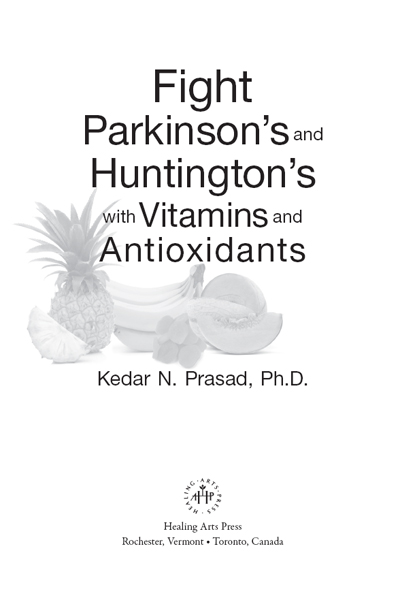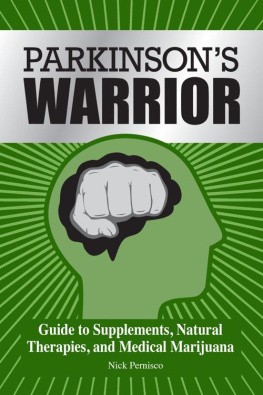
Fight
Parkinsons and
Huntingtons with
Vitamins and
Antioxidants
As the worlds leading scientist and educator on the practical use of a multiple micronutrient strategy to combat leading diseases, Kedar Prasad now addresses Parkinsons and Huntingtons disease in this latest book. After providing a proper background in immunology, antioxidant science, and neurodegenerative disorders and debunking myths for both proactive citizens and clinicians, Prasad provides a rational antioxidant/anti-inflammatory/immune supportive approach that can improve the health of millions. To maximize the benefit of Prasads authoritative research-based advice, buy two copies of this book nowit may well be the most valuable addition to your physicians practice!
JAMES E. EHRLICH, M.D., CLINICAL ASSOCIATE PROFESSOR, UNIVERSITY OF COLORADO, DENVER
Praise for other books
by Kedar N. Prasad, Ph.D.
Fighting Cancer with Vitamins and Antioxidants is a comprehensive and fascinating review of current cancer therapies and the controversies surrounding them. Prasads extensive research has made him one of the leading and respected authorities in the field of antioxidant use during cancer treatment.
JEANNE DRISKO, M.D., CNS, FACN, DIRECTOR OF THE PROGRAM IN INTEGRATIVE MEDICINE, UNIVERSITY OF KANSAS MEDICAL CENTER
Fighting Cancer with Vitamins and Antioxidants is a useful and well-organized antidote to the mass of irresponsible information about vitamins. I applaud Prasad for providing the public with a responsible presentation.
FRANK L. MEYSKENS, JR., M.D., DIRECTOR OF CHAO FAMILY COMPREHENSIVE CANCER CENTER, UNIVERSITY OF CALIFORNIA, IRVINE
Kedar Prasads new book Treat Concussion, TBI, and PTSD with Vitamins and Antioxidants is steeped in deep knowledge of science and biochemistry. Vitamins and antioxidants work best for these conditions when they work in synergy with one another.
WILLIAM JIANG, MLS, AUTHOR OF GUIDE TO NATURAL MENTAL HEALTH: ANXIETY, BIPOLAR, DEPRESSION, SCHIZOPHRENIA, AND DIGITAL ADDICTION
Fight Alzheimers with Vitamins and Antioxidants by Kedar Prasad, Ph.D., contains clinically and scientifically valid information presented in an easy-to-follow format that informs the reader about the value of vitamins, antioxidants, and micronutrients in preventing and/or slowing the symptoms of Alzheimers disease. It captures up-to-date scientific information on the pathology of Alzheimers disease and the state of its therapy and presents a straightforward argument on the values of vitamins and antioxidants.
CLIVEL G. CHARLTON, PH.D., PROFESSOR OF NEUROSCIENCE AND PHARMACOLOGY, SCHOOL OF MEDICINE, MEHARRY MEDICAL COLLEGE
Fight Alzheimers with Vitamins and Antioxidants offers a simple and inexpensive means to delay the onset and progression of the disease. This safe, straightforward approach involves readily accessible vitamins and other micronutrients. Prasads book is full of valid and excellent suggestions on how to interfere with the evolution of Alzheimers. I strongly recommend this book.
STEPHEN C. BONDY, PH.D., PROFESSOR, SCHOOL OF MEDICINE, UNIVERSITY OF CALIFORNIA, IRVINE
ACKNOWLEDGMENTS
I would like to thank my family for their support and encouragement. I also am very thankful to Anne Dillon and Chanc VanWinkle Orzell for their superb editing of this book.
PREFACE
Why Should You Read This Book?
Although humankind suffers many neurological diseases, this book focuses on the neurodegenerative Parkinsons disease and Huntingtons disease. About 1 million people suffer from Parkinsons disease, with about 60,000 new cases diagnosed annually in the USA and 3 million to 4 million people remaining undiagnosed. Huntingtons disease, on the other hand, is estimated to have an incidence of about 1,500 per year.
The direct and indirect cost of Parkinsons disease is estimated to be about $25 billion per year, while the annual cost of treating Huntingtons disease may vary. The average annual medical cost per individual is about $10,500, but it could be as much as $47,000 if caregivers costs are included.
Parkinsons disease is considered a slow, progressive chronic neurodegenerative disease appearing later in life and characterized by the loss of dopamine neurons from the brain, which causes involuntary tremors of the limbs and trunk as well as non-motor deficits and neurological symptoms, including impaired sense of smell, memory loss, and psychiatric symptoms. Parkinsons is the most common form of neurodegenerative disease after Alzheimers disease.
In contrast, symptoms of Huntingtons diseasean incurable and fatal genetic disease caused by a gene mutationappear in young adult life and become progressively worse. The major symptoms of Huntingtons include movement disorders, cognitive dysfunction, and psychiatric problems. The movement disorders are characterized by uncontrolled movement or tics in the fingers, feet, face, or trunk, which become more intense when the individuals are anxious or disturbed. As the disease progresses, other symptoms appear, such as clumsiness, jaw clenching (bruxism), loss of coordination and balance, slurred speech, difficulty swallowing and eating, uncontrolled continual muscular contractions (dystonia), difficulty walking, stumbling, and falling. The cognitive dysfunctions are characterized by progressive loss of memory, including the ability to concentrate, answer questions, and recognize familiar objects.
At present, there is no adequate strategy for the prevention of Parkinsons disease and the mitigation of Huntingtons disease symptoms, and their treatment options remain unsatisfactory. In this book I propose a unified hypothesis that increased oxidative stress and chronic inflammation are primarily responsible for the initiation and progression of these diseases. Therefore, mitigating oxidative stress and chronic inflammation appears to be a logical solution to reduce development or progression in both. The proposed strategy, in combination with standard therapy, may improve management outcomes more than just standard therapy alone.
To reduce oxidative stress and chronic inflammation its essential to increase the bodys levels of all antioxidant enzymes and all standard dietary and endogenous antioxidants. This goal cannot be achieved by the use of the one or two antioxidants that have been used in clinical studies. Therefore, I have proposed that a preparation of micronutrients containing multiple dietary and endogenous antioxidants, B vitamins with high doses of vitamin B3 (nicotinamide), vitamin D3, selenium, and certain polyphenolic compounds (curcumin and resveratrol) should be employed in clinical studies to reduce the risk of development and/or progression of Parkinsons and Huntingtons. These micronutrients are capable of increasing the levels of all antioxidant enzymes by activating a nuclear transcriptional factor 2/antioxidant response element (Nrf2/ARE) pathway, as well as by enhancing the levels of standard dietary and endogenous antioxidants.
Even though some laboratory data exist to suggest that even the genetic basis of neurological disease can be prevented or delayed by micronutrient supplements, the increase in the amount of micronutrients that I propose flies in the face of conventional theory, for most neurologists believe that antioxidants and vitamins have no significant role in the prevention or improved management of neurodegenerative diseases. These beliefs are primarily based on a few clinical studies in which supplementation with a single antioxidant, such as coenzyme Q10 in Parkinsons disease, produced only modest beneficial effects in the study group. Another study demonstrated that vitamin E alone was ineffective in reducing the progression of Parkinsons disease.
Next page


